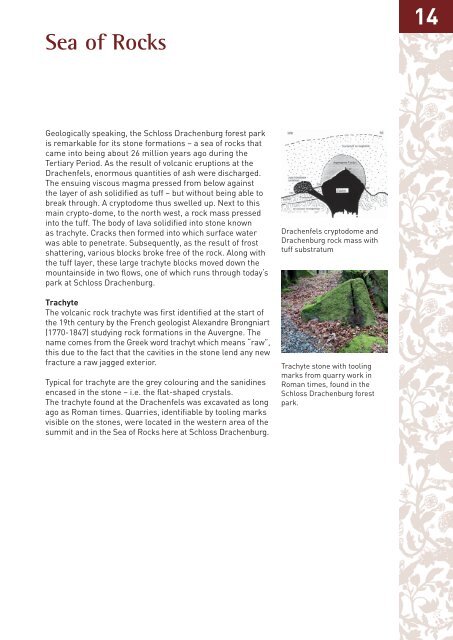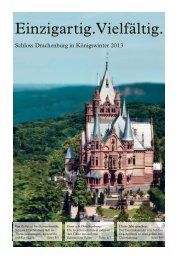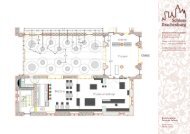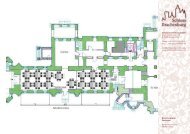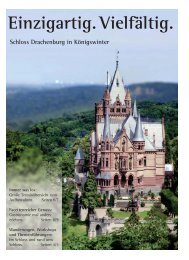North Tower - Schloss Drachenburg
North Tower - Schloss Drachenburg
North Tower - Schloss Drachenburg
Create successful ePaper yourself
Turn your PDF publications into a flip-book with our unique Google optimized e-Paper software.
Sea of Rocks<br />
Geologically speaking, the <strong>Schloss</strong> <strong>Drachenburg</strong> forest park<br />
is remarkable for its stone formations – a sea of rocks that<br />
came into being about 26 million years ago during the<br />
Tertiary Period. As the result of volcanic eruptions at the<br />
Drachenfels, enormous quantities of ash were discharged.<br />
The ensuing viscous magma pressed from below against<br />
the layer of ash solidifi ed as tuff – but without being able to<br />
break through. A cryptodome thus swelled up. Next to this<br />
main crypto-dome, to the north west, a rock mass pressed<br />
into the tuff. The body of lava solidifi ed into stone known<br />
as trachyte. Cracks then formed into which surface water<br />
was able to penetrate. Subsequently, as the result of frost<br />
shattering, various blocks broke free of the rock. Along with<br />
the tuff layer, these large trachyte blocks moved down the<br />
mountainside in two fl ows, one of which runs through today‘s<br />
park at <strong>Schloss</strong> <strong>Drachenburg</strong>.<br />
Trachyte<br />
The volcanic rock trachyte was fi rst identifi ed at the start of<br />
the 19th century by the French geologist Alexandre Brongniart<br />
(1770-1847) studying rock formations in the Auvergne. The<br />
name comes from the Greek word trachyt which means “raw”,<br />
this due to the fact that the cavities in the stone lend any new<br />
fracture a raw jagged exterior.<br />
Typical for trachyte are the grey colouring and the sanidines<br />
encased in the stone – i.e. the fl at-shaped crystals.<br />
The trachyte found at the Drachenfels was excavated as long<br />
ago as Roman times. Quarries, identifi able by tooling marks<br />
visible on the stones, were located in the western area of the<br />
summit and in the Sea of Rocks here at <strong>Schloss</strong> <strong>Drachenburg</strong>.<br />
Drachenfels cryptodome and<br />
<strong>Drachenburg</strong> rock mass with<br />
tuff substratum<br />
Trachyte stone with tooling<br />
marks from quarry work in<br />
Roman times, found in the<br />
<strong>Schloss</strong> <strong>Drachenburg</strong> forest<br />
park.<br />
14


